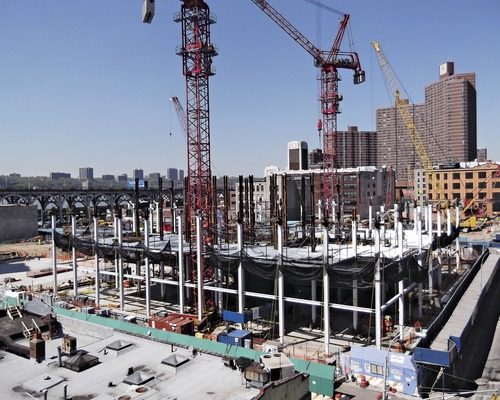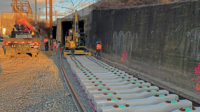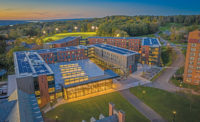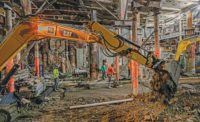Columbia also navigated an extensive master planning design process, led by architects Renzo Piano Building Workshop and SOM. And in 2007, the school tackled the required battery of government environmental and rezoning approvals—all super-sized given the development's scope—as well as varied efforts to meet with community groups, Pitruzzello says.
Work began soon after in 2008 on the sewer upgrades, wrapping up in 2012, while the slurry wall work ran from January 2011 to October 2013. The team dug trenches as deep as 180 ft below street level, filled them temporarily with a bentonite slurry mix and ultimately with reinforced concrete in panels 3 to 4 ft thick and 9 to 29 ft long, Sommer says.
One wall runs along the southern perimeter of the site; another extends north to 131st St. and west to 12th Avenue, covering areas of future development. "What Columbia did proactively is create the slurry wall for many years to come," Sommer says.
Foundation and steel work began in spring 2012 on the three new structures, all of which were designed by Renzo Piano. The first building, Greene Science Center, topped out in October 2013; the second, the central plant, sits under the Lenfest arts building below grade and will power the whole campus; the third, the Lenfest arts building itself, topped out last October.
While Columbia declined to share project budgets, major donors contributed $250 million for Greene and $30 million for Lenfest. Curtain walls for those two buildings are fully enclosed, with both set to open in the fall of 2016, Pitruzzello says.
"That requires a high degree of teamwork and collaboration and communication," he adds.
Going Platinum
Sustainable construction and design resonates across the entire program, from the master plan to each of the 17 buildings planned, feeding the vision to distinguish Manhattanville from the hulking stone structures on the gated main campus, says Antoine Chaaya, architect at Renzo Piano.
"This [new campus] is open to the city, very transparent, luminous," Chaaya says, citing its preservation of the existing street grid and features from parks to publicly accessible ground floors that welcome the community.
Those features notched the first-ever Platinum certification for a university campus from the U.S. Green Building Council's LEED-ND for neighborhood development pilot, which Columbia earned alongside LEED-NC status for the new buildings. The LEED-ND designation gave credit for proximity to bicycle and greenway paths on the nearby Hudson River, access to subway and bus lines, extensive community outreach programs and plans to widen sidewalks and plant trees, Pitruzzello says.










Post a comment to this article
Report Abusive Comment